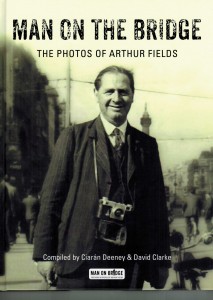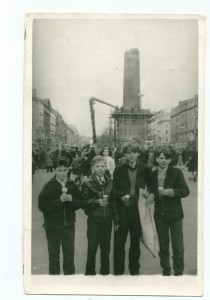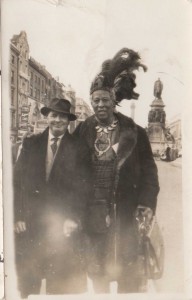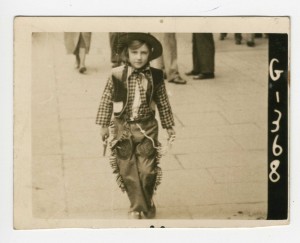Man on the bridge
Published in Issue 1 (January/February 2015), Reviews, Volume 23 El Zorrero Films
El Zorrero Films
RTÉ1, Dec. 2014
Gallery of Photography,
Meeting House Square, Dublin 2, 29 Nov. 2014–8 Jan. 2015
Ciarán Deeney & David Clarke, Man on the bridge: the photos of Arthur Fields (Collins Press, ?24.99 hb, 240pp,
ISBN 9781848892170)
By John Gibney

1966—Peter Pender, Peter Morrissey, Gerard Dereaux and Robert Keane (father of footballer Robbie Keane) eating ice cream days after Nelson’s Pillar was blown up. (Vivian Quinn)
Man on the bridge illustrates how simple ideas are often the best ones. The eponymous man was Arthur Fields, and the bridge on which he stood was O’Connell Bridge (the big one). What he did on the said bridge was take photographs: a conservative estimate is that he took 182,500 in a 50-year career. Now 5,000 have been crowd-sourced and c. 250 have been published in the book of the same name. Man on the bridge is the brainchild of Ciarán Deeney and El Zorrero films, with the support of and input from Arthur Guinness Projects, Collins Press, Dublin City Council, Fáilte Ireland, the Gallery of Photography and RTÉ. The result is a genuine multimedia project consisting of a website, an exhibition, a documentary and a book, all collectively dedicated to recovering Arthur Field’s photographic work.
Fields was born Abraham Feldman in Dublin in 1901 to Jewish parents from the Ukraine. He changed his surname to avoid anti-Semitism—a ‘verbal disguise’, according to his son Bernard (though he signed a photo of an Italian tourist ‘Abraham Feldman’ as late as 1988). He opted for his lifelong occupation because he found it a more attractive prospect than tailoring, and so the young Arthur Fields joined the ranks of Dublin’s street photographers. Many ‘professional’ photographers viewed this bygone trade as the lowest level of their profession and held it in contempt. As the photographer David Davison remarked here, however, ‘it’s people who take photographs, not cameras’, and Fields was a natural photographer.

1955—Arthur Fields posing with passing ‘African prince’ and horse-racing tipster Ras Prince Monolulu. This larger-than-life character (whose real name was Peter) was actually born in the Caribbean.
The favoured ‘strip’ that street photographers worked was the thoroughfare running from O’Connell Street to Grafton Street via Westmoreland Street. Fields, who travelled into work from his home in the north Dublin suburb of Raheny, took O’Connell Bridge itself as his pitch. He would stay there from about 9.30am to 6pm before moving on to cinemas like the nearby Adelphi (courting couples were natural ‘clients’). His trick was simple: having caught the attention of his subjects by pretending to take a picture, he would then take the real thing and a fee would change hands, along with the address of the subject; Fields’s wife would develop the image, and it would be posted out to the person who had paid for it. Honesty and reliability were essential; after all, he could easily be found.

1936—‘cowgirl’ Lona Moran aged four or five. She later worked as a set and costume designer in the Gate and Olympia theatres in Dublin. (Frances Gorman)
What can his pictures tell us? They offer a glimpse of five decades of Irish life as it changed; the consistency of Fields’s vantage points gives the photos coherence as a documentary record. The full range of images can be explored on the superb website www.manonbridge.ie; they are broken down by decade (1930s to 1980s) and by theme: material culture (such as baskets on arms, cars in the background, bikes, handbags, umbrellas), hairstyles, couples, lads out on the town, Christmas, hats, sunglasses, weddings, smokers with fags clenched in hand and mouth, generations of youth culture, GAA fans up for matches and much more. The website also contains a revealing selection of interviews with Fields’s children and a range of other commentators, who explore the significance of the images as a resource for social history, fashion history and street life. There are some familiar faces to be seen: watch out for a very young George Harrison, Maureen O’Hara, Jack Doyle, Brendan Behan, and Phil Lynott busking in the background. But it is the ordinary people who are the stars of this archive; changing attitudes to photography can be seen, as cameras became more familiar over time and people became more inclined to relax in front of them. The images used for the project were crowd-sourced from members of the public. They had to be, for it was impractical for Fields to retain the original negatives (and he had graduated to Polaroid in later life). The images on display were collected from those who still had them or who had inherited them (though, as the organisers concede, images taken by other street photographers will inevitably have crept in).
The documentary tells Fields’s story but his photos are his legacy; c. 250 of them are published in large format by Collins Press, arranged chronologically with explanatory captions by those who contributed them. It makes for a remarkable and very human chronicle; by attaching names to the faces—and sometimes an anecdote, too—these snapshots are brought to life. The intimation of mortality lurking outside the frames highlights the moments of life that they capture: every picture has a story to tell, from a 1941 image of an Irish girl and her US forces sweetheart, taken before his death in World War II, to a 1974 snap of a man walking past one of the locations of the Dublin bombs of that year the night before the blast, with his own reflection on his luck. The lighthearted side of life is here, too: witness Robbie Keane’s father and three friends eating ice creams in front of the ruined stump of Nelson’s Pillar in 1966 (Keane’s grandparents are in here, too). Yet even as hair gets longer and skirts get shorter, one can’t help thinking that much of life remains the same and was quietly chronicled by the man on the bridge. There is a tangible quality to photographic prints that digital images can never match; this handsome book goes a long way towards retrieving that.
Arthur Fields bequeathed a remarkable archive to his native city. If you missed the documentary—and even if you didn’t—visit the exhibition while it is running or obtain a copy of the book while it is still available. And the website will remain live to continue the process of collecting images taken as much of Ireland made its way along O’Connell Bridge and was captured for a fleeting moment. They can be uploaded directly to the site, or via a number of venues in the city that have kindly agreed to facilitate the collection of further images. It is appropriate that many of those venues are public libraries, for this remarkable project amounts to a people’s history in the truest sense.
John Gibney is editor of www.decadeofcentenaries.com.
















